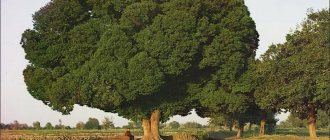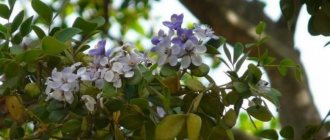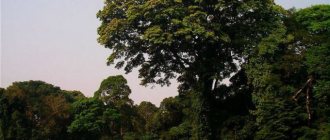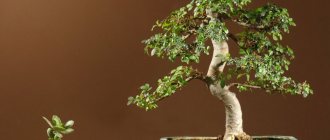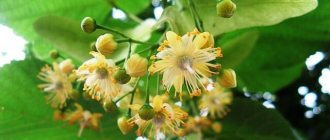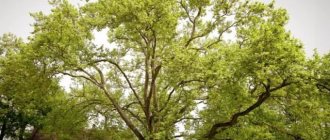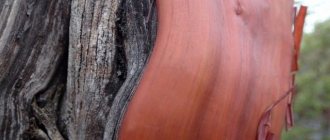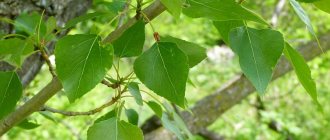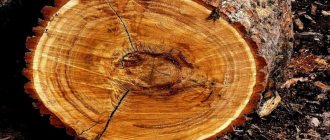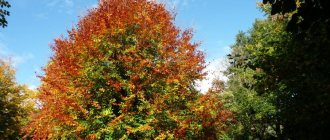General information, brief description
When the tree became especially popular, plantations appeared, created specifically for the purpose of growing trees. Such plantations are created not only in the places where this tree naturally grows, but also in Africa, Costa Rica and Panama.
The tree reaches a height of 40 m, and the number indicating the diameter of the trunk reaches 60 cm.
There are rare specimens whose trunk diameter can reach one and a half meters.
Figurines made from wood of this species were found in Indian caves. Experts have established that this figurine is approximately 2000 years old. However, they have a beautiful appearance and are completely preserved.
The unique color palette of wood makes it possible to use wood for the manufacture of a wide variety of products. When cutting a log, straight fibers are clearly visible and only occasionally wavy fibers can be seen.
Use in medicine
The leaves of this tree have the highest number of medicinal properties. They are used for:
- Treatment of skin ulcers and fungal diseases. The leaves have antibacterial properties, so they are often used to treat skin diseases.
- To stabilize the menstrual cycle. The dried leaves are brewed as tea and used for menstrual irregularities.
- Treatment of hemorrhages. It is also used in the form of dried powder from the leaves in the form of tea leaves.
- Treatment of sore throat (brewed as tea).
In addition to the leaves of the tree, the wood itself is also actively used in medicine. It is ground into the finest powder. The scope of its application is quite wide. This powder is used as:
- laxative;
- remedy against intestinal parasites;
- medicine for dysentery;
- for the treatment of leukoderma;
- for the treatment of certain diseases of the female reproductive system.
Teak wood powder is most widely used in Indian medicine.
It is believed that the bark of the teak tree can be used for diabetes.
Wood sawdust is used in Indonesia. There they are burned like incense.
Photo presentation of the use of teak wood
Teak is actively used for making furniture, including designer furniture. Exclusive models are created from this wood, for example, with carvings or engravings.
Furniture for kitchens, business offices, and so on is made from wood of this species. Teak is very durable, and furniture made from it lasts a very long time.
Teak is a fairly expensive material for construction, however, all material costs associated with preparing this wood for processing and its processing itself are paid off by the durability and ease of use of products made from it.
This is why teak is often used to make decorative interior items made of wood, such as figurines, vases, and so on.
Wood is easy to process, and the products hold their shape well and do not lose their attractive appearance even over time.
Preventive treatment with special protective compounds allows you to preserve the attractiveness of teak products. It is recommended to clean outdoor furniture and other products from dirt and sand them once a year, and then apply a protective compound.
Using teak to decorate a bathroom - video
Description of some types of yew
In Western Europe, the berry yew (Taxus baccata) of the yew (Taxaceae) is often found, so this species is sometimes called the European yew. This is a relatively tall evergreen coniferous tree or shrub. It can be seen in Belovezhskaya Pushcha and in the Kaliningrad region; yew feels good in the Crimea and the Caucasus. In mountainous areas it often grows as a tall shrub. Near Khosta (between Sochi and Adler) on the eastern slope of Mount Akhun there is a relict yew-boxwood grove. In 1931 it became a protected area and is now under the protection of UNESCO. In Scotland there is a very old yew berry, which is about nine thousand years old.
READ Is ironwood really iron?
Yew berry
The garden forms of yew berry are varied: columnar, weeping, dwarf, squat, flattened, creeping and prostrate.
The yew needles are not needle-shaped, but flat. It is usually green or with a bluish tint, in some varieties it is silver-variegated, golden-bronze or with yellow stripes. There are varieties that change the “summer” color of their needles for the winter.
Yew variety " Summergold " has yellowish needles. In the slow-growing variety " Elegantissima ", the needles turn white by winter. This beautiful yew must be well insulated for the winter.
Among the berry yews there are low-growing shrubs with a height of only 0.5 - 1.5 m. These are “ Repandens ” (with blue-green needles, often taking on a creeping crown shape) and “ Elegantissima ”. The " Fastigiata " variety is low-growing in the Moscow region, but taller in milder climates. In winter it often freezes.
Silver Spire hybrid with a columnar crown to be one of the most beautiful . When they bloom, the needles have a yellowish border; later (especially in winter) they become bluish-silver.
The wood of yew berry is hard and heavy, red in color. It joins the large list of species belonging to the “mahogany” tree. The tree does not rot for a long time and has bactericidal properties. It has long been used to make funeral sarcophagi and religious accessories. The wood is highly polished and is used to make expensive carved furniture and jewelry boxes.
All parts of the yew tree are poisonous to people and most pets. Therefore, in some places these trees were cut down after mass poisoning of residents and livestock. There were times when enemies were specially treated to drinks poured into yew goblets. Old plants have the highest concentration of toxins.
Another species, the pointed yew (T. cuspidate), grows into a beautiful winter-hardy tree or shrub. In nature, it can be seen on Sakhalin, the Southern Kuril Islands, Korea, China and Japan. In the Primorsky Territory there is the Lazovsky State Nature Reserve, where on Petrov Island there is a grove of relict pointed yew, which is more than a thousand years old.
The pointed yew has interesting tall and semi-dwarf varieties. Dwarf Bright Gold looks beautiful . Monloo ” with a dense cushion-shaped crown on sale
Even in nurseries there are rarely seedlings of Canadian yew (T. canadensis). This winter-hardy species is represented by low shrubs from eastern North America.
Medium yew is a hybrid of berry and pointed yew, bred at the very beginning of the 19th century in the USA. He gave many wonderful varieties. For example, with a wide pyramidal crown (height 4 m, width 3 m) of the “ Hatfieldii ” variety. Unfortunately, many varieties can freeze in winter. The dwarf variety with a bright green, flattened, wide crown “ Taunton ” (“ Taunyonii ”) is distinguished by its winter hardiness.
Yew hedge
Teak
TIC (botanical name - tectona grandis) is a tall deciduous tree of the verbena family, growing in India, Burma, and Laos. In the Middle Ages, being a sacred tree of Buddhism, it was brought to Indonesia and was initially planted near temples. Nowadays it grows naturally throughout the island of Java and Sulawesi.
| Teak growing area |
The trees reach a height of 50 m with a trunk diameter of up to 150 cm. The length of the trunk to the beginning of the crown can vary from 6 to 30 meters.
Teak
Teak tree fruit
Teak wood belongs to wear resistance class II (it lasts indefinitely when kept under a roof, without contact with wet soil and with good ventilation). Teak is extremely resistant to rot and mold, dries well, but rather slowly, and has very low shrinkage when dried. Once dried, teak wood retains remarkable stability.
- Teak wood
- Specific gravity (t./m3): 0.67 (0.62 – 0.75)
- Strength class: II (high).
- Brinell hardness: 3.6
- Density of Teak wood (kg/m3)*
*Average data are given at 12% humidity. The density of teak wood may vary depending on growing conditions and other reasons.
Teak wood is oily to the touch, dense, quite hard and durable, wear-resistant during friction, highly resistant to rotting, acids and alkalis, and does not corrode metals. Real teak is a deep golden color with a dull shine and rich texture.
Teak texture (uncoated)
The sapwood is narrow, grayish or white. Freshly sawn teak has a reddish hue, but when exposed to the atmosphere it quickly develops a warm beige or golden color with a hint of brown.
Over time, the wood in the room, even if varnished, darkens somewhat.
Without covering with protective oils or varnishes, when exposed to open sunlight, it turns silver-gray.
Pressed teak dust is used as incense. In traditional medicine, lozenges made from teak dust are used as a remedy for headaches and tumors.
Teak is exceptionally durable in the home. In India there are products made from it, made more than 1000 years ago. Due to the presence of a large amount of oily substances, teak is extremely resistant to moisture and aggressive environments. This quality of teak has been valued in shipbuilding for a long time.
Teak deck flooring of the battleship California, USA (launched in 1919, sunk at Pearl Harbor in 1941, raised and restored in 1942, took part in World War II). This teak deck is about 100 years old!
And currently, teak wood is widely used in shipbuilding, yacht finishing, as well as for the manufacture of furniture and other products. Due to its chemical resistance it is used in products exposed to acids.
High stability and bio-resistance allow teak to be used for the production of garden furniture, decking, outdoor terraces and swimming pools. Teak veneer is used to produce high-quality plywood. Teak is often used to make joinery and is also used for wood carving.
There is practically no alternative to teak when finishing “wet” rooms with wood – bathrooms, toilets, pool areas, spas, etc.
Teak is considered one of the most famous woods in the world due to its valuable properties - durability, strength, workability and attractive appearance. Located in the highest price segment. The use of teak wood as flooring goes back decades. Solid teak wood makes excellent parquet and floor boards.
Given the commercial value of real teak wood, in recent years some manufacturers and sellers have used the word “teak” in the names of their products, although in reality they are made from completely different types of wood belonging to other botanical families.
Examples include the commercial names “Brazilian Teak” (the actual name of the species is Kumaru, the family is Leguminosae) and “African Teak” (the actual name is Iroko or Flounder, the family is Mulberry).
Finished goods
The main known uses, they should be taken in light of established practice. Important note: Some uses are mentioned for information (traditional, regional and antique items).
- Shipbuilding (boats and decks)
- Indoor carpentry
- Cladding panels
- Open boats
- Upscale mahogany furniture
- Sliced veneer
- Floors, parquet
- Stairs (internal)
- Cooperage production
- Turning products
- Outdoor joinery
- Facade board / planken
- Terrace board
- Cladding panels for open air
- Lightweight wooden structures
- Blinds
- Bridges (parts in contact with water or ground)
- Bridges (parts not in contact with water or ground)
- Pillars
- Bent products
Teak. Properties of wood. Beneficial features
Home › Structure and composition of wood ›
07.05.2019
Teak wood is a species of deciduous tree in the Lamiaceae family. Teak, which grows up to 40 meters in height, grows in various climatic conditions. The average trunk diameter is 1.5 m, and the length of the trunk to the crown is from 5 to 25 meters.
teak wood
- The main natural habitat of deciduous teak is in India, Thailand, Indonesia, Malaysia, Myanmar. Teak wood is a very valuable species that is exported from Asian countries.
- Teak grows in monsoon forests in rich, well-drained soils. Cultivated in Costa Rica and Panama.
But a teak tree that has grown in natural conditions, rather than artificially cultivated. The tree grows very quickly for a hard tree. After 10 years, teak reaches a height of 10 meters, and at 20 years, its height is closer to 30 meters.
Depending on where it grows, teak wood can be very different. Thus, the tree will grow poorly on clay soils. A teak tree will become branchy if it lacks moisture.
There are three types of teak, the most common of which is common teak .
Teak. Properties of wood
Teak wood is a sound wood species. The sapwood is very narrow, light, with a yellow tint, and the heartwood is golden brown, providing a noticeable contrast to the cut. Teak wood has a pleasant, slightly velvety feel to the touch.
Due to the high silicon content in the wood, when processing it, the tool may become dull, but in general, teak wood is easy to process.
The texture of teak wood is pronounced, with mineral inclusions, which is why it is heterogeneous. The density of wood is 650 kg/m3 at 12% humidity.
Depending on external conditions, teak wood changes its color. Freshly cut teak wood has grayish, reddish, greenish shades of inclusions.
Over time, it acquires a uniform yellowish-golden, lemon or brown color.
Teak wood texture
Teak wood has the smell of old leather due to the essential oils it contains, which make the wood moisture-resistant and resistant to acids.
Drying teak wood requires a very long time, up to several years. Accelerating the drying process will lead to uneven drying of the products in the future and cracking.
Due to its beautiful golden texture, teak wood is used for veneer, cutting boards, flooring, kitchen utensils, furniture, and for interior and exterior decoration.
In addition, due to the fact that teak wood has high moisture resistance and without additional treatments, it is used in the production of garden furniture, ship decks, and so on. By the way, the steering wheel of the cruiser Aurora is made of teak wood.
Teak deck
Teak. Beneficial features
The benefits of teak wood are to produce hard, beautiful and high-quality wood
Growing teak Subscribe to our Yandex.Zen Teak channel. Properties of wood. Useful properties Link to main publication
Furniture stylistics
It is desirable that teak furniture fit naturally into the country house setting and harmoniously combine with the house:
- Therefore, to recreate a corner of Provence, furniture of classical shapes is selected: sofas and armchairs with armrests, a round table. Furniture cushion covers are made from pastel-colored fabrics with small floral patterns;
- If a country house is built in a modern style, then it is better to install furniture of simple straight shapes. Plain fabrics are suitable for upholstering pillows;
- To maintain the village atmosphere in a country house, objects of simple, even somewhat rough shapes (wooden benches, stools) are installed. Products that are decorated with simple carvings and floral patterns are welcome.
Teak items decorate not only the open terraces of cottages, but also look great in SPA complexes around the world. Such furniture will always be popular and in demand due to its reliability.
Teak (tekton grande) | Directory | Timber | Wooden construction
Teak, or tectona grandis, family (Lamiaceae) of mints - the name of the species comes from the Greek word tecton, which means “to carpenter.” The specific epithet translated from Latin means main or large.
Other names for teak: Burmese teak, Rangoon tonic, Moolmein teak, Indian teak.
Grows in India, Vietnam and other countries of South and Southeast Asia (Myanmar (Burma), Malaysian Peninsula, Thailand).
Teak wood has an oily feel to the touch, has the smell of old leather, is dense, quite hard and durable, wear-resistant during friction, highly resistant to rotting, acids and alkalis, and does not corrode metals. Teak shows outstanding durability in dry and wet conditions. This quality of teak has been valued in shipbuilding for a long time.
In the cave temples of India, built 2000 years ago, teak wood is in good condition. In terms of physical and mechanical properties, teak wood is close to silver birch wood, but inferior to oak and larch wood.
Widely used in shipbuilding and port facilities, as well as for the manufacture of chemical equipment, furniture and other products.
Teak is a hardwood hardwood with light brown narrow sapwood and a yellow to dark brown core. The annual layers are quite clearly visible; in a cross section, their boundaries are often wavy.
The medullary rays are narrow and poorly visible. The annual layer begins with large vessels located one at a time, less often two in a row; the diameter of the vessels decreases towards the outer boundary of the annual layer.
Teak trees are extremely varied in cultivation, being sensitive to terrain, soil and climatic conditions. Typically, teak grows to a height of 50 meters with a trunk diameter of 1.5 meters. In Burma, some trees are 2.5 meters in diameter. The length of the trunk to the beginning of the crown can vary from 6 to 30 meters.
Teak is a hardwood tree that can be found in virtually unspoiled areas. Although teak grows in a variety of soil types, good drainage is a prerequisite. Teak usually grows on low-lying slopes and is extremely rarely found at altitudes exceeding 900 meters above sea level.
The leaves of the tree are 25 cm long and 15 cm wide.
True teak has a deep golden color that turns to dark brown or almost black when exposed to the atmosphere for long periods of time. Plantation teak is different from original teak - the surface of the wood is very different in color.
It is common for plantation teak to have irregular patterns of dark stripes or spots. Narrow sapwood of grayish or white color. The wood has a distinct leathery smell and no noticeable taste. Characterized by a dull shine. When freshly cut, the tree has a sticky, oily surface.
The average density coefficient is 0.55 (weight of dried wood/volume of freshly cut wood), which corresponds to an air-dried wood density of 672 kg/m3. The fiber is smooth stripes with periodic inclusions. The wood has a coarse texture.
Teak has excellent strength characteristics, which allows it to be used in a variety of construction needs.
Teak dries well, but rather slowly, shrinkage is very slight. Average shrinkage rates (when drying fresh wood in a chamber) are: radial - 2.5%, tangential - 5.8%, volumetric - 7.0%. You can air dry or oven dry. Once dried, teak retains remarkable stability.
In general, teak is processed well, however, there are some difficulties in working with the tool. In tooling it is necessary to use thin cutting blades. It is necessary to use good steel and reduce rotation speeds. Treated wood surfaces remain sharp.
Habitat
Tectona grandis, or teak (wood), also has the following names: Rangoon or Burmese tonic, Mulmein, Indian teak. Distribution area: India, South and Southeast Asia in the region of Burma, Thailand, and the Malaysian Peninsula. Due to the great popularity of teak wood products, it began to be actively grown on plantations. The differences between wild and plantation teak are in the internal color of the wood, but no fundamental differences were found in the main performance qualities.
In nature, the tree reaches a height of 40 meters, a trunk diameter of up to 60 centimeters, but in rare cases there are specimens with a diameter of 1.5 meters. Teak plantations, in addition to its traditional habitats, are located in Panama, Africa and Costa Rica.
We will tell you about Tika
The homeland of teak furniture is South and Southeast Asia.
Here, in the dense jungles of India, Burma, Thailand, Java and Sumatra, generously warmed by the sun and drenched by tropical downpours, this amazing tree grows.
Teak is also grown on artificial plantations (for example, in Germany). Outwardly, both types are almost indistinguishable, but in terms of its practical properties, plantation teak is inferior to forest teak.
Indonesian wood contains a unique set of components, which determines the high resistance of teak furniture to negative external influences:
- temperature changes;
- high level of humidity;
- chemicals;
- wood pests;
- ultraviolet.
Teak furniture: properties important to buyers
- It has been noticed that over time the positive characteristics of teak only intensify. Almost the only thing it changes is its color. It seems to be tanning, and the natural light yellow gives way to a noble dark brown. In this regard, teak furniture is comparable to elite alcohol or works of art - only more valuable over the years.
- When you become the owner of teak furniture, you join a special club. Moreover, you are making an investment in the future - after all, it will serve you for decades! And if you ever decide to sell your furniture, you will be able to gain capital that is an order of magnitude greater than the initial investment.
- But that's not all. Teak furniture creates a unique atmosphere in the surrounding space (be it a home or office) in the literal and figurative sense of the word. It emits a subtle, pleasant aroma that gives it a special charm.
- As for Russia, the distant tropical guest came in handy here. He is not afraid of the capricious and often not particularly friendly climate with high humidity and a fluctuating thermometer. Teak generously shares the warmth inherent in nature, filling your home with comfort, beauty and style.
Application of teak
Thus, teak is one of the most spectacular and valuable materials in the production of exclusive furniture and interior items.
Along with new wood, so-called reclaimed wood is actively used - wood that has “served up” its age, but still remains suitable for use. These are “decommissioned” ships, dismantled buildings, and engineering structures.
Teak furniture is distinguished by unpretentiousness, durability and reliability, coupled with the beauty of the wood pattern and visually-tactilely attractive texture. A sort of thoroughbred Oxford graduate: hereditary external aristocracy and muscles pumped up from rowing.
If we leave the lyrics aside, teak furniture does not require final decorative and strengthening treatment (painting, varnishing, etc.). This is truly environmentally friendly material! It is equally good for indoor and outdoor use.
It is not surprising that such characteristics of teak wood have historically been in demand in areas where products that are used in extreme conditions are needed. First of all, in shipbuilding.
For example, the hull of the cruiser Aurora contains many teak parts.
The most famous buildings made of teak are the royal palace of Vimanmek (Bangkok) and Ubein - the longest and oldest wooden bridge in the world, located in Myanmar.
Areas of use
Solid teak is used for flooring indoors and on terraces.
The front layer of this floor has a bright color, original and expressive texture. Due to its moisture resistance characteristics, it can be used in any premises, including those where flooring of other materials is not possible. Used as flooring in:
- Public places with high traffic.
- In residential areas.
- In rooms with high humidity levels: in the bathroom, toilet, kitchen, near swimming pools.
- For decks and floors in shipbuilding. This use is explained by the fact that even when varnished, the wood is not slippery.
- Boards made from this material are used for arranging terraces, balconies, loggias, and in landscape design.
- This board was used in the manufacture of furniture, house construction, in the manufacture of carved headboards and other elements. Although they are expensive.
Solid teak board on the deck of a yacht
Teak (wood) is... What is Teak (wood)?
teak flowers
Flowers, fruits and leaves
Bridge in Amarapura, Myanmar. The longest teak bridge in the world, 1.2 km long.
Tree in fresh foliage in Kolkata, West Bengal, India
Teak
, or
teak tree
(lat.
Tectona grandis
) is a species of deciduous trees of the genus Tectona of the Lamiaceae family. It grows in the monsoon forests of South and Southeast Asia. Teak wood is a source of very valuable wood and is one of the most important types of wood exported in Asia.
Distribution and growing conditions
Natural habitat of teak wood
(lat.
Tectona grandis
) is located in India, Indonesia, Malaysia, Myanmar, northern Thailand and northwestern Laos.[3][4]
It has several varieties and grows in a variety of climates, from arid areas with only 500 mm of rainfall per year to rain forests with 5,000 mm of rainfall per year. Typically, however, rainfall in teak areas averages 1,250-1,650 mm per year, with a dry season of 3-5 months.[5]
Description
Teak
- a large deciduous tree growing up to 40 m in height, with gray or grey-brown branches. The leaves are oval, 15-45 cm long and 8-23 cm wide, thick petioles 2-4 cm long. The edge of the sheet is smooth.[3]
It blooms from June to August with white fragrant flowers, collected in panicles 25-40 cm long and 30 cm wide. Petal tube 2.5-3 mm long with blunt petals 2 mm wide. The fruits ripen from September to December; spherical fruits 1.2-1.8 cm in diameter.
[3] The flowers are slightly protandrous and the stamens mature before the pistils and pollen is released several hours before the flower opens.[4] The flowers are primarily entomophilous (pollinated by insects), sometimes anemophilous (pollinated by wind).
[6] A 1996 study found that in areas of its native range in Thailand, these trees are most often pollinated by bees of the genus Ceratina.[4]
Pests
Teak wood is quite resistant to damaging factors, both biological and extra-biological.
Caterpillars of various butterflies can cause some damage by eating teak leaves, and the tree can also be infested by various semi-parasitic species of the genus Limegrass. Hyblaea puera
, an insect native to Southeast Asia, is a pest of teak, with its caterpillars feeding on teak and other tree species native to the region.[7]
The heartwood of a tree is affected only occasionally, for example by wood borers (Xyleutes ceramicus) and fungal pathogens of heart rot.
Phytopathogenic viruses and bacteria infect these trees very rarely. The main causative agents of fungal diseases are: Armillaria mellea, Fomes lignosus, Fomes noxius, Heterobasidium compactum, Irpex flavus, species of the genus Nectria, Olivea tectonae (“teak leaf rust”), Peniophora rhizomorpha (“yellow layered rot”) and Polyporus zonalis (“white bag rot").
In plantations, damage may occur due to trampling or stripping of trees by elephants. Teak wood is relatively resistant to fire.
Cultivation
The bulk of the teak wood on the market comes from teak plantations located in Indonesia and controlled by Perum Perhutani (the state-owned forestry company), which manages the country's forests. The main use of teak wood harvested in Indonesia is in the production of teak furniture for export.[8]
The increasing consumption of teak has caused an increase in related problems such as the disappearance of old teak trees.
However, its popularity has led to a steady increase in teak plantation cultivation in areas with seasonally dry tropical climates.
The Forest Stewardship Council issues certificates for products made from plantation-grown teak. It is economically profitable to propagate teak for plantation purposes using tissue culture.[9]
The bulk of teak in the world is exported from Indonesia and Myanmar. Plantations are also developing rapidly in Central (Costa Rica) and South America.
Reproduction
Most often, teak is propagated using seeds. For germination, seeds require pre-treatment, which consists of destroying the thick pericarp. In addition, soaking and drying the seeds is used.
The seeds are immersed in water for 12 hours and then dried in the sun for 12 hours. The procedure is repeated for 10-14 days, and then the seeds are sown in small germination containers filled with coarse peat sprinkled with sand.
After this, germination occurs within 15-30 days.[10][11]
Usage
Main article: Teak (wood)
The beautifully grained golden-brown teak wood is used for garden furniture, ship decks, and other applications where weather resistance is required. It is also used for cutting boards, floors, tabletops and as veneer for furniture and interiors.
Teak wood is easy to work with, but can dull tools because it contains silicon. Natural teak oil makes it resistant to termites and rot, making this wood suitable for outdoor applications. Teak is stable even without additional treatment with protective agents.
The wood obtained from old teak trees is considered much more durable and harder than plantation teak wood.
However, studies have shown[12] that plantation-grown teak has the same rot resistance, spatial stability, degree of warping and number of surface defects as old trees, but is more susceptible to discoloration when exposed to ultraviolet rays.
Teak is a hardwood tree species native to India, Burma, Thailand, Sumatra and Java. Teak wood:
- dense, durable and hard;
- golden brown;
- has a large and expressive texture;
- has high resistance to decay;
- contains essential oils that make processing difficult;
- used in shipbuilding, furniture production and construction.
Teak wood is resistant to termites.
Literature
- M. Schorcht: Tectona grandis
.
In: Peter Schütt et al.: Bäume der Tropen
. Nikol, Hamburg 2006, pp. 635–644. ISBN 978-3-933203-79-3
Links
Elm - Ilm, Berest and Karagach
In the distance, a dome-shaped green crown could be seen above the forest. The slender, stately fellow Elm stood at the edge of the forest. Strong, thick, hook-like roots clung to the soil. Firmly and confidently, the tree knight stood up to defend the centuries-old forest.
Elm image
In Rus', it was believed that the branches of Elm bring not only good luck, but also give courage and strength to a faithful traveler on a long journey.
In Christianity, Elm symbolizes dignity and is a sacred tree.
For many peoples, this strong tree of the elm family was a symbol of mother and birth, transition to a new life.
For the English, an Elm branch with a vine is a sign of faithful lovers.
elm names
Elm got its name due to the characteristics of its wood. The fact is that in the old days, sleighs, rims and much more were “knitted” from bast wood. Bast was extracted from the subbark layer.
The Latin name of the tree is Ulmus. According to one version, it comes from the ancient Celtic word elm.
The tree has many names. The most common names are Ilm, Berest and Karagach.
What Elm looks like
Elm is a tall, slender tree of the elm family. The tree has smooth bark, strong roots and a dome-shaped crown of dense, large leaves.
In Russia, the most common is the Common Elm (or Smooth Elm). This tree reaches 25 meters in height. The girth of the trunk can exceed one and a half meters.
The bark has a light brown tint and begins to flake off on older trees. The old Elms, mottled with wrinkles, resemble wise elders who preserve the knowledge of humanity.
Elm fruits are small lionfish with a nut in the center. They can be used in carpentry, folk medicine and even cooking.
Where does Elm grow?
There are about 16 species of elm. It is found in Western Siberia and Kazakhstan, the Southern Urals, the Caucasus and the Volga region, as well as in European countries and even Scandinavia.
Species native to Central Asia are called “Elm”.
Elm prefers fertile soil, reaching large sizes with proper care. Despite this, in natural conditions, Elm can easily tolerate drought and flood. In addition, Elm is a frost-resistant tree.
In nature, Elm is found in deciduous forests, along the banks of rivers and lakes, rarely forming pure stands.
When does Elm bloom?
Elm blooms in March or April for only 10 days a year with small purple flowers. The fruits and nuts ripen in May–June.
Medicinal properties of Elm
In folk medicine, bark, fruits, and leaves are used.
A decoction of Elm bark has an astringent and diuretic effect and is used for intestinal diseases. It is also used to treat rheumatism and edema, as well as skin problems.
Bark extract is used medicinally as an antibacterial and anti-inflammatory agent.
Use of elm in industry
Elm wood is durable and flexible. It often replaces expensive breeds, successfully being dyed.
Elm is a favorite wood of cabinetmakers. Its dark brown wood is prized for making bent furniture and for setting veneer paintings in marquetry. The veneer of the tree roots is especially valued - the so-called butt part.
In addition, Elm wood is moisture resistant and was often used in the past in the construction of bridges and dams.
Elm is often used in parks and gardens, despite problems with pests attacking these beautiful trees. The dense crown of Elm allows the plant to be trimmed into bizarre shapes.
Interesting Facts
In Korea, Elm grows over 800 years old. The height of the trunk of this magnificent tree is 7 meters, the diameter is about 2 meters.
Until 2010, in Moscow on Povarskaya Street there was an old long-living Elm tree that survived the fires of 1812. Unfortunately, during the abnormally hot summer of 2010, the Elm dried out.
In the Middle Ages, Elms were used in vineyards as supports. That is why the Elm tree was associated with the god of wine Dionysus among the ancient Greeks.
In China, Elm fruits are used in cooking as one of the ingredients in salads.
Due to the wood's resistance to moisture, Elm wood was used in the construction of the famous London Bridge.
Let's sum it up
Concluding the review of the properties and features of teak oils, we would like to remind you that in a short article it is impossible to outline all the technical nuances of the process of creating high-quality decorative coatings.
At the same time, the finishing of wooden houses and terraces is the most critical stage of their construction, errors during which can nullify all efforts to create an original design.
The best way to avoid such mistakes is to entrust finishing work to professionals who have all the necessary equipment and practical experience.
Our company is an official dealer of such brands as Osmo, Teknos, Gnature, Tikkurila, Aquatex and Biofa, which guarantees regular training and certification of specialists involved in the direct creation of coatings using oils of these brands.
performs all types of work related to the finishing, restoration and repair of log or timber frame buildings, including the creation of oil-based protective coatings. Services are provided on-site at any construction site in Moscow or the Moscow region. To clarify the details of cooperation and agree on the sequence of work, please contact us using any type of communication from those published on the “Contacts” page.
Calculate the cost of painting and insulating your home right now
Data from the CIRAD database
Countries of origin. Vietnam, India, Indonesia, Laos, Malaysia, Myanmar (Burma), Thailand, Philippines, Sri Lanka, plantation teak - also Fiji, African countries (Cameroon, Congo (Kinshasa), Nigeria) and Central America (Honduras).
Description of logs
Diameter, cm 50–100 Thickness of sapwood, cm 2–6 Buoyancy no Preservation in the forest is good
Description of wood
Color yellow-brown Sapwood clearly defined Texture rough Straight fiber No intertwined fibers
.
The wood darkens over time with the appearance of a golden tint. Sometimes black-brown veins. Oily to the touch. Physical properties
| Average | Delta | |
| Density, g/cm³ | 0,67 | 0,06 |
| Monnin hardness¹ | 4,2 | 1,3 |
| Volumetric shrinkage coefficient, % | 0,34 | 0,07 |
| Total tangential shrinkage, % | 4,7 | 0,8 |
| Total radial shrinkage, % | 2,6 | 0,4 |
| Fiber saturation point, % | 24 | — |
| Sustainability | sustainable |
Mechanical properties
Average Delta Compressive strength¹, MPa 56 6 Bending strength (4 points)¹, MPa 98 13 Longitudinal elastic modulus (4 points)¹, MPa 13740 2749
¹ at 12% humidity;
1 MPa = 1 N/mm² Physical and mechanical properties based on mature heartwood samples. These properties can vary greatly depending on origin and growth conditions. . The properties of wood grown on a plantation and in the forest are usually similar, with the exception of durability. Natural durability and permeability
| Class | Description | |
| Fungi | 1 | very resistant |
| Woodworms | sustainable | sapwood expressed (risk limited to sapwood) |
| Termites | M | moderately persistent |
| Permeability | 4 | impenetrable |
| Biohazard class | 4 | in contact with the ground, fresh water or severe dampness |
.
Biohazard class provided by natural resistance (according to EN standards). . The durability of plantation teak is much lower than that of forest teak. Plantation teak is moderately resistant to fungi and is classified as susceptible to termite attack. Plantation teak from Asia and elsewhere has a resistance class of 1-3 against fungi and a class MS (moderately resistant to susceptible) against termites. If the silica content is high, teak from natural wood may be classified as Biohazard Class 5 (use in marine and brackish waters). Resistance to fungi and termites is given for finished products in temperate climates. Except for special comments for sapwood, natural durability is given for mature heartwood. Sapwood should always be considered as not resistant to destructive factors. Local names by country
| A country | Local name |
| Great Britain | teak |
| Vietnam | giati |
| Germany | java teak, teak |
| India | sagwan, teak |
| Indonesia | jati, tek |
| Italy | teck |
| Laos | may sak |
| Myanmar (Burma) | kyun |
| Netherlands | teak |
| Thailand | may sak, teak |
| France | teck |
The need for protective treatment
Against borers does not require any protective treatment In case of risk of temporary wetting does not require any protective treatment In case of risk of permanent wetting does not require any protective treatment
Drying
Drying speed is slow No or negligible risk of warping No risk of cementation No or negligible risk of hairline cracks No risk of destructive cracks
Possible drying modes
Humidity, % Drying temperature, °C Air humidity,% dry steam fresh 42 41 94 40 48 43 74 30 54 46 63 20 60 51 62 15 60 51 62
These modes are given as an example only and for thicknesses not exceeding 38 mm. They must be applied in accordance with accepted practice. For thicknesses from 38 to 75 mm, the relative humidity should be increased by 5% at each step. For thicknesses over 75 mm, the increase should be 10%.
Drying speed may vary from board to board depending on their density and significant differences in the moisture level of freshly cut boards.
Sawing and processing
| Dull cutting edges | strong |
| Recommended saws | stacked teeth |
| Cutting edges | with tungsten carbide |
| Peeling | Not recommended |
| Planing | Fine |
Variable silica content.
Sawdust dust can cause skin irritation. Assembly
| Nails, screws | good, but requires pre-drilling |
| Gluing | normal |
Pre-drilling is recommended due to slight tendency to cracking from nails/screws. Satisfactory bonding of surfaces that have been freshly treated or sanded (wood contains oily resins).
Ticknet
The International Teak Wood Information Network (Teaknet), maintained by the Food and Agriculture Organization (FAO) Asia Pacific Regional Office, Bangkok, currently has its offices at the Kerala Forest Research Institute, Peechi, Thrissur, Kerala, India. Teaknet is an international network of organizations and individuals interested in teak. Teaknet serves the interests of all categories of teak stakeholders, whether producers, traders, researchers or other groups with a deep interest or concern about teak. From time to time, the organization formulates action plans targeting the short and long term needs of the global teak sector. Teaknet[38] provides information to anyone involved in the research, conservation, cultivation, management and use of teak.
Features of the material
- Solid teak is easy to cut, which is important if parquet planks are made from it.
- The board is fed to cutting and processing with carpentry tools.
- Dyes penetrate into the wood structure, making the color natural and even.
- Nails and screws hold tightly to the board. During installation, you can even use parquet glue.
- This material can be turned, glued, and polished.
- Dries well, but slowly.
- A floor that is laid using solid teak has excellent durability. The color is bright and rich, and the texture pattern is rich. With just one look, it fills the room with warmth and comfort, adding a touch of individuality.
Teak board on the bathroom floor
- Interior use
- Solid planks are large panels of wood that come together to form a durable deck. Teak has excellent decorative qualities, which opens up the possibility of being used as a design element and even a central component. A massive board makes the interior original and unique. It is impossible to find two identical boards.
- Most often, such a floor is laid in bright rooms, as a material that adds zest to the design solution.
- The upper part of such a floor is not covered with anything, since it can have an excellent appearance without treatment and at the same time maintain its technical characteristics for many years. To further extend its service life, the board can be coated with a special varnish.
- Solid teak flooring creates a pleasant microclimate in the room, because the boards have the property
Solid teak board on the terrace
- Care
- Special care for teak floors is not required; it is limited to wet cleaning. If the board is used on a terrace or other open areas, it must be cleaned of dust and dirt, as it can be absorbed into the surface. Dirt can only be removed by sanding and removing the top layer. But this does not affect the technical characteristics of the material.
- From time to time, outdoor teak boards are coated with a protective varnish, so they will last even longer.
- Conclusion
- Solid teak is a convenient and practical material that is used in various fields. It is easy to handle and does not require special care. Although the price is high.
average rating
more than 0 ratings
Share link
Botanical history
Tectona grandis
It was first formally described by Carl Linnaeus the Younger in his 1782 work
Addendum Plantarum
.[11] In 1975, Harold Norman Moldenke published new descriptions of four forms of this species in the journal
Phytology
.
Moldenke described each form as slightly different from the type specimen: T. grandis
f.
canescens
differs from the type material in the density of braided, or covered with hairs on the underside of the leaf,
T. grandis
f.
The pilosula
differs from the type material by the different morphology of the leaf veins,
T. grandis
f.
the point
is covered with hairs only on the larger veins on the underside of the leaf, and
T. grandis
f.
Tomentella
is distinguished by dense yellowish pubescent hairs on the lower surface of the leaf.[12]
Notes
- For the convention of indicating the class of dicotyledons as a superior taxon for the group of plants described in this article, see the section “APG Systems” of the article “Dicotyledons”.
- ↑ 1 2 3
[efloras.org/florataxon.aspx?flora_id=2&taxon_id=200019434
Tectona grandis
].
Flora of China
17: 16. Accessed online: 17 December 2010. - ↑ 1 2 3
Tangmitcharoen, S. and J. N. Owens.
1996. [aob.oxfordjournals.org/content/79/3/227.full.pdf+html Floral biology, pollination, pistil receptivity, and pollen tube growth of teak ( Tectona grandis
Linn f.).]
Annals of Botany
, 79 (3): 227–241. DOI:10.1006/anbo.1996.0317 - Kaosa-ard, A. 1981. Teak its natural distribution and related factors. Nat.
His. Bull. Siam. Soc. , 29: 55-74. - Bryndum, K. and T. Hedegart. 1969. Pollination of teak ( Tectona grandis
Linn.f.).
Silv.
Genet. 18: 77-80. - Herbison-Evans, Don
[linus.socs.uts.edu.au/~don/larvae/hybl/puera.html
Hyblaea puera
]. University of Technology, Sydney (6 September 2007). Retrieved 12 March 2008. [web.archive.org/web/20080724111814/linus.socs.uts.edu.au/~don/larvae/hybl/puera.html Archived from the original on 24 July 2008]. - [www.regencyteak.com/ 25% off Teak Furniture – Teak Outdoor Furniture – Regency Teak]
- Teak tissue culture company: wtamc.com/PlantingMaterials.htm
- Kadambi, K. (1972). Silviculture and management of Teak. Bulletin 24 School of Forestry, Stephen F. Austin State University Nacogdoches, Texas
- B. Robertson (2002) Growing Teak in the Top End of the NT. Agnote. No. G26 [www.nt.gov.au/d/Content/File/p/General/812.pdf PDF]
- [www.fpl.fs.fed.us/documnts/pdf2001/willi01d.pdf United States Department of Agriculture - Home]
- [www.hindustantimes.com/photos-news/Photos-World/oldestteakbridge/Article4.aspx Oldest teak bridge] (English) on the website hindustantimes.com
- [www.boston.com/bigpicture/2012/03/myanmar.html The Big Picture - Myanmar - Photo #5] (English) on boston.com
, March 26, 2012
